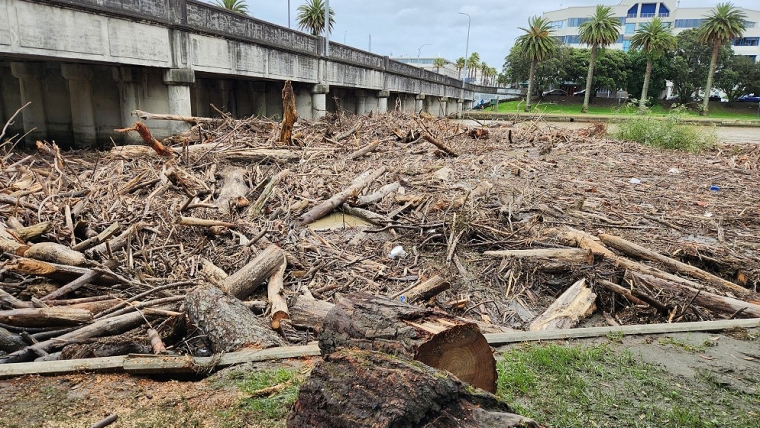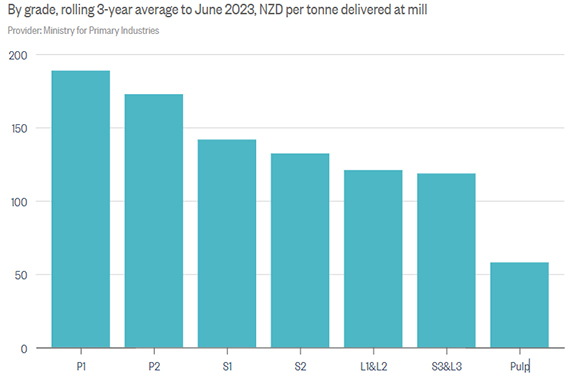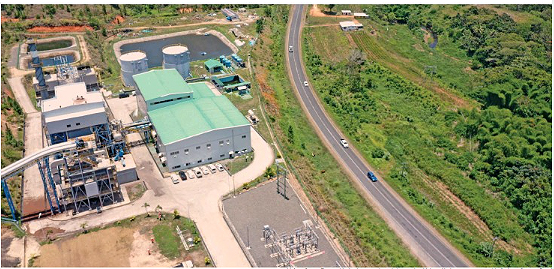
Most people, especially on the East Coast and Tairawhiti Gisborne have welcomed the new regulations regarding the control and removal of slash in the forestry sector. The new rules come into force November this year.
What appears to be missing is what happens to all the new and existing slash.
According to a Gisborne District Council (GDC) report, around 500,000 tonnes of slash/pruning’s are produced per year on the East Coast alone. A quick look at the farm forestry site and I found that between 8% -10% of harvested timber is waste. Also, there is around 220,000 ha of forestry in the East Coast Tairawhiti, Wairoa region and if 3.6% (28 year cycle) is harvested annually and yields 600 tonnes per year, 9% is around 428,000 tonnes of slash produced annually.
Somewhat less than the GDC statement but still a lot of slash ‘resource’ never-the-less.
On top of this are the pruning’s and thinnings done before we arrive at the harvesting stage, so perhaps that could be where GDC get their figure. Much has been made about the lack of economics in ‘salvaging’ slash for other uses and helping to alleviate the impact of floods. However, the government has spent over $10m alone on subsidised slash removal to get rid of 70,000 tonnes which comes to $145 per tonne. A quick look at forestry returns shows the average return per tonne of harvested forestry is around $130 per tonne. And there has been considerably more spent elsewhere and at other times on slash removal.

Source: Figure.nz
So, what this shows is that the 70,000 tonnes which is about 12% of the annual slash production is a drop in the ocean and the cost of removal is way out of proportion to the returns from forestry.
To me, this creates a bit of a problem for forestry, regional councils and government about what they are going to do about it in the future.
Quite a bit has been said about the introduction of a bio-energy plant some where in the East Coast region to utilise the slash in some form of mode more useful than just building huge bonfires along what used to be pristine beaches. I was recently in Fiji and en-route to ‘resort’ we drove past the Nabou Bio-energy plant.
Established with support from South Korea, the plant utilises 300 tonnes (depending upon dryness and may be now greater with an upgrade taking place) of timber waste daily. The aim has been to supply upto 35 MW of electricity annually (Which I think is about ¼ of the “First Light” supply to the Tairawhiti region). The total cost of the Nabou project in 2016 was put at US$45 mln.

If I took a punt and said it costs energy companies about 15 cents to produce a kwh at 35,000mwh that’s a $5.25 mln return annually, or if 90,000 tonnes of slash are utilised (300 tonnes per day x 300 days) then a return of $58 per tonne. No doubt someone with better information could drive a train though this but it does make you wonder why given how long the East coast has had a major and growing problem with slash why something more positive hasn’t been done sooner.
Putting a cost on slash will no doubt bring a lot more potential solutions to the table and power generation may just be one of them. But what we do know is that something creative needs to be done and throwing good money after bad cleaning up after weather events is not a solution.
The slash from forestry is also only part of the problem and while possibly the greatest and most damaging percentage of timber in water ways, given the eroding nature of the geography in the region there is also a lot of indigenous, poplar and willow that’s ends up flowing towards the coast.
The LinkedIn report of 2020 damage to the Tikapa beach and slippage on surrounding hills testifies to. So a potential timber resource for bio-fuel is likely to be considerably greater than the theoretical numbers. Fiji not only uses waste timber but has local coppicing forests to also provide fuel.
A project like bio-fuel in conjunction with utilising slash would have be a likely candidate for the now (it appears) defunct Climate Emergency Response Fund (CERF).
In addition to the new slash requirements, the government has announced a new $30.25 per hectare charge for forests, as well as new fees for 22 services, such as changing the classification of exotic or indigenous areas and asking for more time to collect forest measurements. Needless to say, forestry companies are not happy about the new charges and hit back, saying the levy is another government disincentive to plant forests when they are most needed.
25 Comments
re ... "... but it does make you wonder why given how long the East coast has had a major and growing problem with slash why something more positive hasn’t been done sooner."
Kiwi "investors" would rather buy existing houses for an un-taxed capital gain than invest in something practical like harvesting slash. (Kiwi "investors" also believe government must do everything, and if they don't, government has failed ... Meanwhile, real investors just get on and make things happen. Of course, real investors would act far quicker with a deeper pool of investment capital.)
Have I mentioned that NZ's tax system results in sub-optimal capital allocation? I have? Sorry. Just done it again.
You have a choice this week. The only parties who have plans to overhaul our tax system are the Greens, TOP and TPM. A purple vote only protects the status quo.
The East Coast had a slash problem long before plantation forestry came a long. High time for a change in bridge design. But no, we are putting the same bridges back in as the old ones, 'cause it's cheaper that way.
Check out the beaches 20 seconds in:
But there was a big plantation planting boom starting in the 1920s?
Not on the East Coast. There would have been less than 100,000 tonnes coming out of there in 1990. A lot of it was done post Bola to control erosion. Is more natural forest/scrub than plantation.
From your link: "State and private forests were mainly in the central North Island. Although the Forest Service continued to plant sizeable areas to meet regional timber needs at Eyrewell and Balmoral in Canterbury, Karioi on the southern flanks of Mt Ruapehu, and Riverhead in Auckland, most effort was concentrated on the Kāingaroa plains."
So you are saying there was no plantation forestry in East Coast from 1920? They only started planting plantation there in 1970? Source?
The video is rather limited in its quality, its tough to tell what it is on the beaches other than some tree debris, volumes aren't indicative either, but it looks like a lot less than what we see up there now. I wouldn't call the video evidence of it being a bigger problem or not one way or the other, it shows some debris on the beach after a storm, like you see everywhere.
Source? Have a read of you own link before you post perhaps?
"Timber towns, such as Kawerau, Murupara and Tokoroa, were established in the 1950s as harvesting and processing of the first forests began." Note - none of these towns are on the East Coast.
There was no plantation forestry on the East Coast in the 1920's (or 1948). There was only 70,000 tonnes (~130 hectares) harvested as late as 1990. Trees washed down rivers and deposited on beaches isn't a new thing. Take a trip to Fiordland.
Profiles right. Here in Europe I've seen massive amounts of forest debris in Slovenia, Italy, Switzerland and Slovakia etc All caused by big storms. A lot of bridges are designed to handle this, if in Prague just look at approaches to bridge piles - simple but effective, and in one case a lake marina choked in debris having to be removed - not a harvest site around. People here understand forests and natural ecosystems unlike NZ where we have destroyed them, hate trees and are happy for millions of tonnes of soil to flow of the land annually.
I'm not condoning some harvest practices at all but lots of woody debris on beaches is part of the natural ecosystems- not clear beaches for walking dogs and swimming at our leisure- that state causes ecological genocide for many species.
Biomass has options but it's expensive to pickup small wood and requires capital cost. It can be done and is common all over Europe.
I have a family member who is into studying rivers. Their research agrees that one of the changes we have brought to country is there is now less woody material in our river beds and consequently beaches.
Doesn't mean we need to create the mess we have with slash but does suggest our idea of pristine waters does not always correlate with natural.
Don't get me wrong I'm not condoning poor harvest practice at all. As you say our definition of "good" does not align with our natural ecosystems as we see good as being the way we want things to be for our pleasure and enjoyment plus we can't seem to comprehend that the removal of native forests on many sites is the cause of most of the problems we have today. To fix the problem we need to return it to some form of permenant forest cover.
"our idea of pristine waters does not always correlate with natural". Yep red, last time I went for a swim in the Heaphy river a bit up from the mouth at the Heaphy Hut, there were trees and wood stacked up all along the banks. And the mouth had 15 foot high piles along the beach. And none of that is slash.
Again, you lack evidence. The source I provided talks about it being "mainly" in those places, that doesn't mean to say it wasn't being done elsewhere at a smaller scale.
I don't know if you have actually visited Fiordland, I tramp there whenever I am down that way. There is a considerable difference between what is on the shores of Fiordland which is the occasional large log and lots of driftwood and that of the East Cape right now. I cycled the East Cape a few years ago and it was huge logs and tree debris right up and down the coast, until teams came and cleared it. Hilarious if you think they are equivalent.
It is common industry knowledge chap. Here is your obscure statistic with a ten second google. Note not 1920 and not 1948. 70,000 tonnes were exported in 1990 which would coincide with this 1959 planting. Is this enough supporting evidence for you or do I need to get in to PapersPast? You're welcome. Perhaps read your own lnks in future?
"The forests of Gisborne (Tairawhiti) were historically planted for erosion control, but from the first softwood forest plantings in 1959... "
Where's Whakatane again? Rangitaiki river? Pukahunui?
The forest was of 41000 acres planted, starting in 1925, on the Pukahunui block and was owned originally by Matea Lands Ltd., a company set up to farm the block. Because of the cobalt deficiency in the pumice soils of the block the farming venture failed as the stock died. The owners were left with this huge block of land and it was then that the block was planted in pine trees.
https://collection.fletcherarchives.co.nz/objects/80699/whakatane-board…
Where?! - Bay of Plenty/Central North Island chap. This article is about the East Coast and Gisborne
That was my conclusion also profile, after traveling around the area recently. Bridges are like grids that collect debris. They should design single span bridges and all woody debris will just wash out to sea as has happened for millions of years.
I do shake my head when I see councils or transit fulling in a gap a river has gouged. That's where the river wants to go, let it.(unless there is no room).but longer spans are alot more expensive.
The breadth of what you can produce from trees and add value is so much wider than energy as evidenced by the fact that Scandinavia doesn't have a slash problem because they use so much of the tree for different end products.
Like the Wood Fibre Futures reports, if Te Uru Rakau keeps asking small questions of their advisors, they will keep getting small answers that advantage incumbents at local optima that don't get to an overall optimum that balances its chemical, biological, mineral and energy potentialities for each Region and the wider country and shared climate.
We don't need to try too hard to find better models overseas. Let's get smarter about getting value from the resources we have
Swedish forestry is flat - they don't have cable logging, only ground based. The glaciers piled over the top of it and smoothed it out. New Zealand has a lot of steepland forestry. Forests there also have a deep duff layer as don't get harvested until 70 years plus. If we remove all the slash we are going to have to replace all the nutrients - the needle/slash layer is the nutrient bank for the next rotation.
Sweden burns some slash (and in fact forestry companies have to apply a Government prescribed burn to 5% of their forestry land to mimic fire perturbation).
Is there any initiative to sequester the carbon in the form of biochar which when added to the farm soil also fixes nutrients so they don't leach into rivers? The process of making biochar can also harness the energy for heating/electricity. I would imagine there are difficulties of scale, but I would imagine it would be a good sideline for commercial greenhouse operations and things of that nature.
Pine Slash is industrial WASTE. Don't feel sorry for pine forest owners, as they would have left long ago, it they weren't making money. Yet they have the audacity to ostensibly threaten NZ with continuing to purportedly, knowingly, facilitate dumping potentially millions of tonnes of their future pine excrement into our public environment & private land; allegedly unless NZ'ers ostensibly continue to wipe their slash covered ass’s, purportedly with billions of dollars in Govt subsidies, which could be better spent. Want to sue the Forestry Industry for damages; or want to know how to economically and practically recycle or prevent pine slash from leaving your farm, contact us today: nzdisasterengineer@gmail.com
One could easily change 'pine' to 'pasture' and your comment would be the same. Erosion of farmland is an even greater problem.
Putin & Trump favourite, point a dirty finger off the point.
Probably the biggest contender for the dry year energy problem from the latest report regarding Onslow, was to create (or Convert Huntly) a bunch of generators that can be spun up using a product made from wood remnants (the factory to make these pellets would also need to be built as well as the supply lines). I reckon build the pellet factory outside Tokoroa nearby the wood supply, then truck the pellets to a converted Huntly. Build cost would be dramatically lower than Onslow and be carbon neutralish (if Transport was decarbonised and the factory made to run off its own electricity).
You don't need pellets. Sawdust can injected directly in to Huntly. They looked at it 30 years ago but were too tight to even pay for the transport costs of the free sawdust.

We welcome your comments below. If you are not already registered, please register to comment
Remember we welcome robust, respectful and insightful debate. We don't welcome abusive or defamatory comments and will de-register those repeatedly making such comments. Our current comment policy is here.